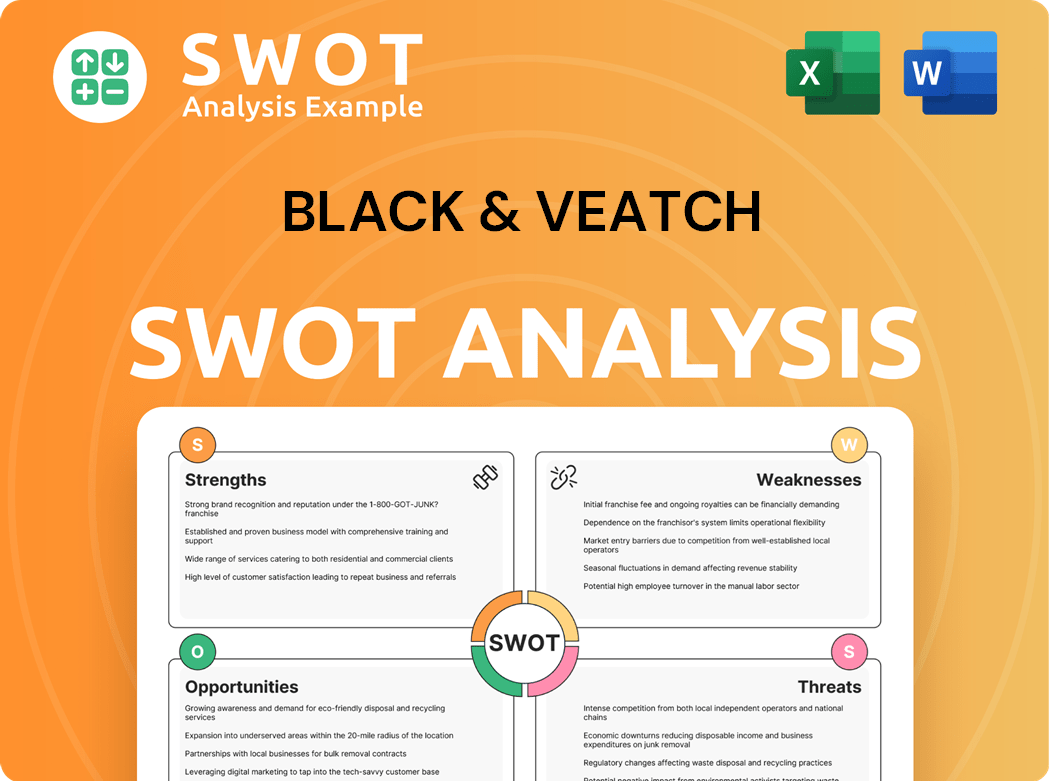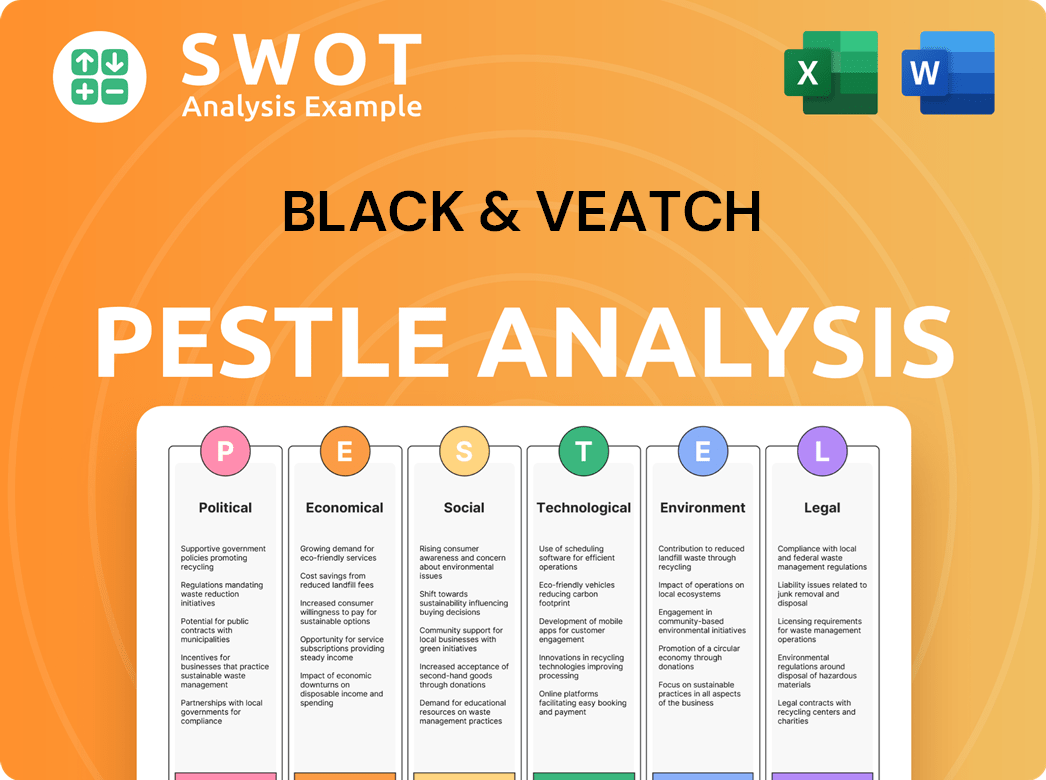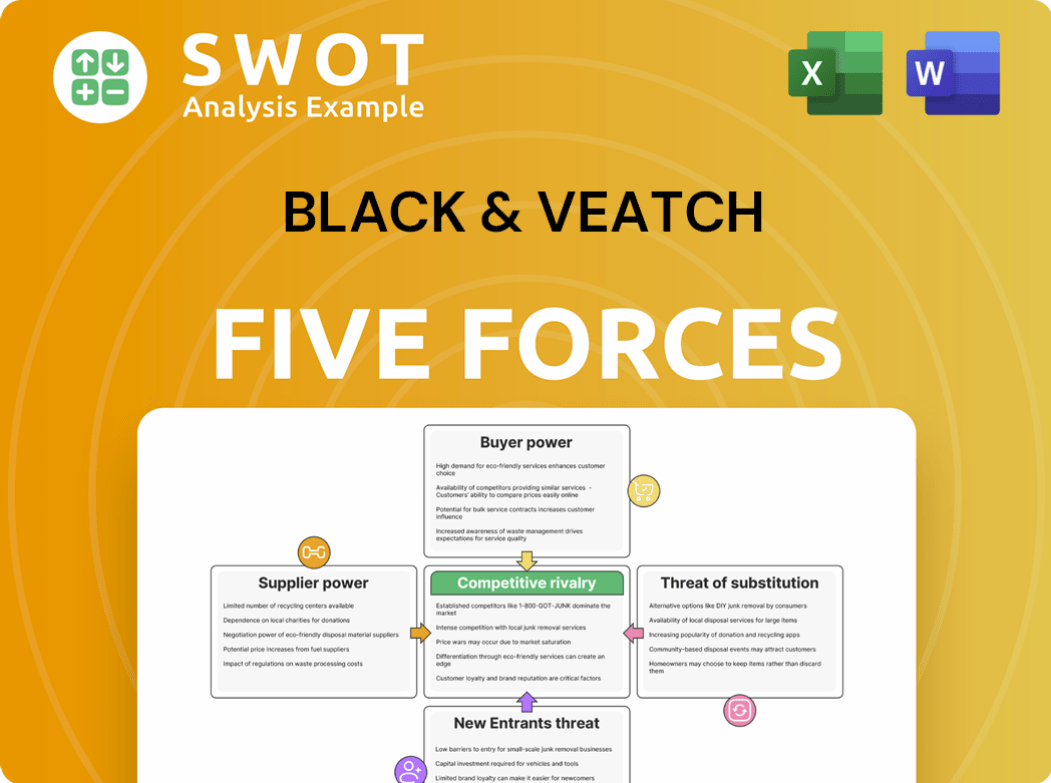Black & Veatch Bundle
How did Black & Veatch become a global infrastructure leader?
Journey through the Black & Veatch SWOT Analysis to uncover the secrets of this engineering company's remarkable evolution. From its inception in 1915, Black & Veatch has shaped the world's infrastructure, tackling complex challenges in energy, water, and telecommunications. Explore the Black and Veatch history and discover how a small team in Kansas City grew into a global force.

This brief history of Black & Veatch reveals a company built on innovation and resilience. Witness how Black & Veatch's early projects and unwavering commitment to quality propelled its growth. With a focus on sustainable solutions, Black & Veatch continues to influence global infrastructure, making it a fascinating story of perseverance and impact.
What is the Black & Veatch Founding Story?
The story of Black & Veatch, a prominent engineering company, began on August 12, 1915. This marked the official founding of the firm by Ernest Bateman Black and Nathan Thomas Veatch. Their partnership laid the groundwork for a company that would become a major player in infrastructure projects worldwide.
Both founders were alumni of the University of Kansas. Before establishing Black & Veatch, they had worked together at Worley & Black, a firm where they gained valuable experience. The initial office, located in downtown Kansas City, Missouri, started with a team of just 12 employees.
The formation of Black & Veatch was driven by the increasing need for specialized engineering services, especially in water and electricity. The company quickly established a strong presence in the market, setting the stage for its future growth and impact on global infrastructure.
Black & Veatch's early focus was on providing engineering and design services for water and electric plants. This focus quickly expanded to include government projects, starting in 1917.
- The U.S. Government War Department enlisted Black & Veatch to oversee the construction of military training camps during World War I. This marked the beginning of their strong ties with federal work.
- The company's name, Black & Veatch, simply reflected the surnames of its founders, solidifying their partnership and shared vision.
- Early funding came primarily through their partnership.
- The predecessor firm completed projects for over 100 communities and private companies by the end of 1914.
For more insights into the company's ownership structure, you can explore Owners & Shareholders of Black & Veatch.
Black & Veatch SWOT Analysis
- Complete SWOT Breakdown
- Fully Customizable
- Editable in Excel & Word
- Professional Formatting
- Investor-Ready Format

What Drove the Early Growth of Black & Veatch?
The early years of the Black & Veatch company were marked by significant growth and adaptation. The Black and Veatch history reveals how the company navigated economic challenges and expanded its service offerings. This period saw the firm evolve from its initial focus to encompass a broader range of engineering and infrastructure projects.
During the Great Depression, Black & Veatch diversified its services to include appraisals and rate studies for utilities. This strategic move helped the engineering company to weather financial difficulties. By 1935, the company's headquarters moved to the Country Club Plaza in Kansas City, Missouri, reflecting its growth.
The company's relationship with the government deepened during World War II. In 1940, the War Department requested Black & Veatch to rebuild Camp Robinson in Arkansas. Following the war, the company was engaged by the Atomic Energy Commission, leading to the creation of its Federal Division in 1946.
The post-war era also saw Black & Veatch expand into the electric power sector. This involved moving from small system designs to major assignments for large power companies. This expansion marked a key milestone in the Black & Veatch company timeline.
International expansion began in 1963 with the formation of Black & Veatch International, with its first project in East Pakistan (now Bangladesh). In 1964, the company opened a regional office in Denver, Colorado. Acquisitions in the 1980s, like Moore Gardner & Associates in 1982 and the Pritchard Corporation in 1985, further diversified the company's capabilities. To learn more about their strategic growth, read about the Growth Strategy of Black & Veatch.
Black & Veatch PESTLE Analysis
- Covers All 6 PESTLE Categories
- No Research Needed – Save Hours of Work
- Built by Experts, Trusted by Consultants
- Instant Download, Ready to Use
- 100% Editable, Fully Customizable

What are the key Milestones in Black & Veatch history?
The Black & Veatch company's journey is marked by significant achievements in engineering and infrastructure. From its early projects to its current global presence, the company has consistently adapted and innovated. A look at the Revenue Streams & Business Model of Black & Veatch offers further insights into its operations.
| Year | Milestone |
|---|---|
| 1915 | Founded by Ernest B. Black and Nathan Thomas Veatch, the company began as a partnership focused on municipal infrastructure. |
| 1999 | Became an employee-owned company, fostering long-term strategic decision-making. |
| 2019 | Launched the IgniteX Innovation Accelerator program to foster new solutions. |
| 2020 | Committed to ceasing participation in new coal-based design and construction projects, focusing on renewable energy. |
| 2024 | Became the leading solar design firm in the United States. |
The Black & Veatch company has consistently embraced innovation in its projects. A key example is the development of PRICO® technology, which is used in a significant portion of the world's floating liquefied natural gas (FLNG) projects.
The company's commitment to sustainability is also evident in its goals and achievements.
This technology is used in half of the world's FLNG projects either in operation or under construction or contract.
In 2024, the company became the leading solar design firm in the United States, having installed over 50 gigawatts (GW) of renewable solar projects globally.
Ranked as the No. 2 firm in the design of hydrogen facilities and battery storage systems in 2024.
The company aims to achieve net-zero greenhouse gas emissions across Scopes 1, 2, and 3 by 2050, relative to a 2019 baseline.
Launched in 2019, the program has involved over 45 startups and invested more than $3 million in non-dilutive funding and in-kind services.
From 2019 to 2023, the company saw a 43% decline in Scope 1 and 2 emissions and a 31% decrease in overall GHG emissions.
Despite its successes, Black & Veatch has faced various challenges. These include adapting to changing market demands and addressing industry-wide issues.
The company continues to navigate these challenges through strategic initiatives and investments.
In 2024, the company strategically divested its public carrier wireless telecommunications infrastructure business to Dycom Industries for $150 million.
The company addresses challenges like aging infrastructure, affordability, and supply reliability in the water sector, as highlighted in its 2025 Water Report.
Cybersecurity threats and workforce shortages are ongoing concerns in the U.S. water sector, with 95% of utilities prioritizing cybersecurity investment.
Established in 1999, this model allows for long-term strategic decisions.
The company committed in 2020 to cease participation in new coal-based design and construction projects to focus on renewable energy, which is part of its core values.
The company maintains its presence in private wireless telecom networks and grid modernization solutions.
Black & Veatch Business Model Canvas
- Complete 9-Block Business Model Canvas
- Effortlessly Communicate Your Business Strategy
- Investor-Ready BMC Format
- 100% Editable and Customizable
- Clear and Structured Layout

What is the Timeline of Key Events for Black & Veatch?
The Black & Veatch company has a rich history, starting in 1915 when Ernest Bateman Black and Nathan Thomas Veatch established the firm in Kansas City, Missouri. Over the years, it has evolved from early government work during World War I to becoming a global leader in engineering and infrastructure projects. Key milestones include the formation of Black & Veatch International in 1963, the move to a 100% employee-owned structure in 1999, and the launch of the IgniteX Innovation Accelerator program in 2019. Recent developments show a commitment to sustainable infrastructure and a focus on the energy transition, hydrogen, and water sectors.
| Year | Key Event |
|---|---|
| 1915 | Ernest Bateman Black and Nathan Thomas Veatch form Black & Veatch in Kansas City, Missouri. |
| 1917 | Begins government work, supervising construction of military training camps during World War I. |
| 1935 | Headquarters moves to Country Club Plaza in Kansas City, Missouri. |
| 1946 | Federal Division created to handle projects for the Atomic Energy Commission. |
| 1963 | Black & Veatch International is formed, marking global expansion. |
| 1976 | Completes construction of new headquarters building in Overland Park, Kansas. |
| 1985 | Acquires Pritchard Corporation, expanding into petrochemical engineering. |
| 1999 | Company transitions to a 100% employee-owned corporation (ESOP). |
| 2019 | Launches the IgniteX Innovation Accelerator program to foster startup collaborations. |
| 2020 | Announces cessation of participation in new coal-based design and construction projects. |
| 2023 | Reports total revenue of $4.735 billion and is recognized as the 10th largest 100% employee-owned company in the U.S. |
| 2024 | Ranked No. 1 solar design firm in the U.S. and No. 2 in hydrogen facilities and battery storage system design. |
| 2024 | Divests its public carrier wireless telecommunications infrastructure business. |
| 2025 | Releases its 2025 Water Report, highlighting challenges in the U.S. water sector, including data center water demands and cybersecurity. |
| 2025 | Black & Veatch's IgniteX Innovation Accelerator program opens applications for its 2025 cohort, with the program running from July 28 to October 28. |
Black & Veatch is strategically focused on sustainable infrastructure development. This includes investments in the energy transition, hydrogen, and water sectors. The company is committed to achieving net-zero greenhouse gas emissions across all scopes by 2050, aligning with the Paris Agreement.
The company is actively involved in major green hydrogen projects globally. This includes the Advanced Clean Energy Storage I (ACES I) in Utah. Black & Veatch is showcasing its expertise at events like the All-Energy Summit and World Hydrogen Summit in Europe in May 2025, highlighting its expertise in the field.
The 2025 Water Report highlights ongoing challenges in the water sector. These include aging infrastructure, regulatory uncertainty, and increasing water demands from data centers. This indicates a future focus on resilient water solutions.
The IgniteX Innovation Accelerator program continues to foster startup collaborations. Applications for the 2025 cohort are open, with the program running from July 28 to October 28. This demonstrates a commitment to leveraging disruptive technology.
Black & Veatch Porter's Five Forces Analysis
- Covers All 5 Competitive Forces in Detail
- Structured for Consultants, Students, and Founders
- 100% Editable in Microsoft Word & Excel
- Instant Digital Download – Use Immediately
- Compatible with Mac & PC – Fully Unlocked

Related Blogs
- What is Competitive Landscape of Black & Veatch Company?
- What is Growth Strategy and Future Prospects of Black & Veatch Company?
- How Does Black & Veatch Company Work?
- What is Sales and Marketing Strategy of Black & Veatch Company?
- What is Brief History of Black & Veatch Company?
- Who Owns Black & Veatch Company?
- What is Customer Demographics and Target Market of Black & Veatch Company?
Disclaimer
All information, articles, and product details provided on this website are for general informational and educational purposes only. We do not claim any ownership over, nor do we intend to infringe upon, any trademarks, copyrights, logos, brand names, or other intellectual property mentioned or depicted on this site. Such intellectual property remains the property of its respective owners, and any references here are made solely for identification or informational purposes, without implying any affiliation, endorsement, or partnership.
We make no representations or warranties, express or implied, regarding the accuracy, completeness, or suitability of any content or products presented. Nothing on this website should be construed as legal, tax, investment, financial, medical, or other professional advice. In addition, no part of this site—including articles or product references—constitutes a solicitation, recommendation, endorsement, advertisement, or offer to buy or sell any securities, franchises, or other financial instruments, particularly in jurisdictions where such activity would be unlawful.
All content is of a general nature and may not address the specific circumstances of any individual or entity. It is not a substitute for professional advice or services. Any actions you take based on the information provided here are strictly at your own risk. You accept full responsibility for any decisions or outcomes arising from your use of this website and agree to release us from any liability in connection with your use of, or reliance upon, the content or products found herein.